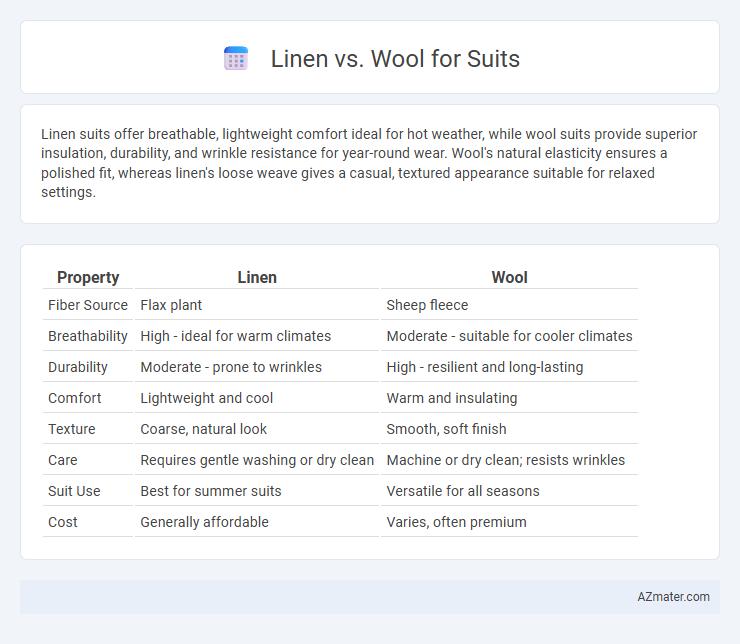Linen suits offer breathable, lightweight comfort ideal for hot weather, while wool suits provide superior insulation, durability, and wrinkle resistance for year-round wear. Wool's natural elasticity ensures a polished fit, whereas linen's loose weave gives a casual, textured appearance suitable for relaxed settings.
Table of Comparison
| Property | Linen | Wool |
|---|---|---|
| Fiber Source | Flax plant | Sheep fleece |
| Breathability | High - ideal for warm climates | Moderate - suitable for cooler climates |
| Durability | Moderate - prone to wrinkles | High - resilient and long-lasting |
| Comfort | Lightweight and cool | Warm and insulating |
| Texture | Coarse, natural look | Smooth, soft finish |
| Care | Requires gentle washing or dry clean | Machine or dry clean; resists wrinkles |
| Suit Use | Best for summer suits | Versatile for all seasons |
| Cost | Generally affordable | Varies, often premium |
Introduction: Linen vs Wool Suits
Linen suits offer exceptional breathability and lightweight comfort, making them ideal for warm weather and casual settings. Wool suits provide superior insulation, durability, and wrinkle resistance, suited for year-round wear and formal occasions. Choosing between linen and wool depends on climate, occasion, and desired fabric performance in suit tailoring.
Material Composition and Origins
Linen suits are crafted from fibers of the flax plant, primarily grown in regions such as Ireland and Belgium, known for producing long, smooth fibers that create breathable, lightweight fabric ideal for warm climates. Wool suits derive from sheep fleece, originating mainly from Australia and New Zealand, offering natural insulation, moisture-wicking properties, and durability suited for cooler weather. The distinct material compositions influence the texture, weight, and climate adaptability of linen versus wool suits.
Breathability and Comfort
Linen suits offer superior breathability due to their loosely woven fibers, allowing air to circulate freely and keeping the wearer cool in hot weather. Wool suits provide excellent moisture-wicking properties and regulate temperature effectively, making them comfortable for both warm and cool climates. While wool is softer and drapes well, linen's lightweight texture delivers unmatched comfort in high humidity and heat.
Durability and Longevity
Wool suits offer superior durability and longevity compared to linen, thanks to their resilient fiber structure and natural elasticity that withstands daily wear and retains shape over time. Linen, while breathable and lightweight, tends to wrinkle easily and undergoes fiber weakening with repeated use, reducing its lifespan for formal attire. Investing in wool ensures a suit that maintains its form and appearance through extended wear and multiple cleaning cycles.
Climate Suitability
Linen suits excel in hot and humid climates due to their lightweight, breathable fibers that wick moisture and provide superior ventilation. Wool suits, particularly those made from lightweight or tropical wool, offer excellent temperature regulation and moisture-wicking properties, making them suitable for cooler or variable climates. Both fabrics adapt to different conditions, with linen best for summer heat and wool ideal for maintaining comfort in moderate to cold environments.
Appearance and Style Differences
Linen suits exhibit a naturally textured and breathable fabric, offering a lightweight appearance with visible slubs that create a casual, relaxed style ideal for warm weather. Wool suits present a smoother, more polished finish with a denser weave, imparting a structured silhouette that enhances formality and drapes elegantly for year-round wear. The subtle sheen and refined fiber of wool contribute to a sophisticated aesthetic, while linen's matte surface and natural wrinkles emphasize an effortless, laid-back look.
Wrinkle Resistance and Maintenance
Wool suits offer superior wrinkle resistance due to their natural elasticity and fiber structure, making them easier to maintain for long-lasting sharpness. Linen suits, while highly breathable and lightweight, wrinkle easily and require regular steaming or pressing to maintain a polished appearance. Choosing wool ensures lower maintenance and a consistently refined look, ideal for formal occasions and extended wear.
Cost Comparison: Linen vs Wool
Linen suits generally cost less than wool suits due to the lower price of raw flax fibers and simpler manufacturing processes. Wool suits, particularly those made from high-quality merino or cashmere blends, tend to have higher price points reflecting their durability, insulation properties, and fine craftsmanship. Budget-conscious buyers often prefer linen for its affordability, while those prioritizing longevity and luxury may invest more in wool options.
Best Occasions for Each Fabric
Linen suits excel in warm weather settings such as summer weddings, beach parties, and casual outdoor events due to their lightweight and breathable qualities. Wool suits are ideal for formal occasions, business meetings, and cooler seasons, offering durability, warmth, and a polished appearance. Selecting between linen and wool depends on the event's temperature, dress code, and desired comfort level.
Conclusion: Choosing Your Ideal Suit Fabric
Linen suits offer breathability and a lightweight feel, making them ideal for hot weather and casual settings, while wool suits provide superior durability, wrinkle resistance, and insulation, perfect for year-round wear and formal occasions. Selecting your ideal suit fabric depends on climate, occasion, and maintenance preferences, with wool excelling in versatility and linen favored for comfort and style in warm environments. Consider fabric weight, weave quality, and care requirements to ensure your suit meets both functional and aesthetic needs.

Infographic: Linen vs Wool for Suit
 azmater.com
azmater.com